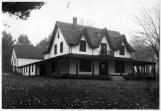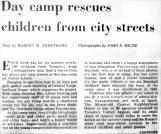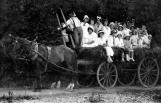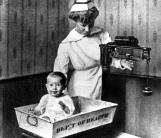1
Residents also now had options for summer excursions.In 1918, Walter Laidlaw even donated his Lake Simcoe home, The Gables, to provide children and adults with a camp retreat. From post-World War I until as late as 1953, generations of Ward and Cabbagetown residents participated in swimming, hiking, boating and bonfire activities. A 1920 house publication reported that the camp was attended by "school children, factory hands, salesgirls, truck drivers, printers, newsboys, high school and university students, professional boxers and baseball players, and drifters,as interesting, representative and promising a group as the ward could produce."In order to help this diverse population, CNH established a well-baby clinic and a milk depot in 1913 that offered free health services . -the first advances into public health, as they addressed the neighbourhood's 20% infant mortality rate. By interceding with city officials, courts and landlords, they also advocated for the rights of their residents, such as a1924 case report that outlines how a mother of six was released from jail after having stolen seven milk tickets.
2
Walter C. Laidlaw at Camp Gables1922
Simcoe Lake, Ontario
 Credits:
Credits:Central Neighbourhood House Records
4
Sleeping in tents at The Gables1930s
Simcoe Lake, Ontario
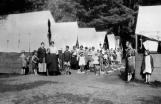 Credits:
Credits:Central Neighbourhood House Records
5
Water fountain at Camp Gables1920s
Simcoe Lake, Ontario
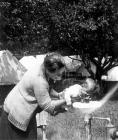 Credits:
Credits:Central Neighbourhood House Records
6
Mothers and children arriving at Camp Gables1920s
Simcoe Lake, Ontario
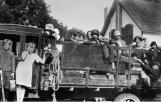 Credits:
Credits:Central Neighbourhood House Records
9
In order to help this diverse population, CNH established a well-baby clinic and a milk depot in 1913 that offered free health services - the first advances into public health, as they addressed the neighbourhood's 20% infant mortality rate. By interceding with City officials, courts and landlords, they also advocated for the rights of their residents, such as a1924 case report that outlines how a mother of six was released from jail after having stolen seven milk tickets.12
Staff member with baby at Camp Gables1930s
Simcoe Lake, Ontario
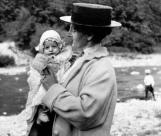 Credits:
Credits:Central Neighbourhood House Records
13
Alert baby and happy care-taker1920s-1930s
Central Neighbourhood House, Toronto
 Credits:
Credits:Central Neighbourhood House Records
14
Mother and children in The Ward1920s
Downtown Toronto
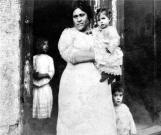 Credits:
Credits:Central Neighbourhood House Records
